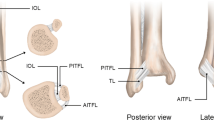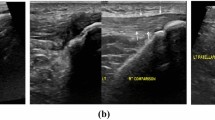Abstract
The purpose of this study is to determine the additional effect of high-intensity laser therapy (HILT) when combined with therapeutic exercise and splinting in the treatment of patients diagnosed with de Quervain’s tenosynovitis. Nineteen patients diagnosed with de Quervain’s tenosynovitis were randomly divided into two groups: the HILT group and the sham HILT group. A total of 9 HILT or sham HILT sessions were administered, with 3 sessions per week for 3 consecutive weeks. Both groups received the thumb spica splint and therapeutic exercise. A comparison was conducted between the two groups, as well as pre- and post-treatment, focusing on the following outcomes: Visual Analog Scale (VAS) for pain, hand grip strength, and Thai version of Patient-Rated Wrist and Hand Evaluation (PRWHE-Thai) as a disability score. No significant differences were found between the HILT group and the sham group across all evaluated outcomes. However, when examining changes within each group over time, both the HILT and sham groups showed significant reductions in pain and improvements in disability score at the follow-up assessments compared to baseline. On the other hand, no statistically significant differences were observed in grip strength outcomes at any of the measured time points. The combination of HILT with a splint and exercise demonstrates effectiveness as a method for pain management and functional improvement in patients with subacute de Quervain’s tenosynovitis. It is important to note that HILT does not offer any additional advantages when compared to the combined use of a splint and exercise.

Similar content being viewed by others
Data availability
The data that support the findings of this study are not openly available due to reasons of sensitivity and are available from the corresponding author upon reasonable request.
References
Walker-Bone K, Palmer KT, Reading I, Coggon D, Cooper C (2004) Prevalence and impact of musculoskeletal disorders of the upper limb in the general population. Arthritis Rheum 51(4):642–651. https://doi.org/10.1002/art.20535
Ranney D, Wells R, Moore A (1995) Upper limb musculoskeletal disorders in highly repetitive industries: precise anatomical physical findings. Ergonomics 38(7):1408–1423. https://doi.org/10.1080/00140139508925198
Abi-Rafeh J, Kazan R, Safran T, Thibaudeau S (2020) Conservative management of de Quervain stenosing tenosynovitis: review and presentation of treatment algorithm. Plast Reconstr Surg 146(1):105–126. https://doi.org/10.1097/prs.0000000000006901
Goel R, Abzug JM (2015) de Quervain’s tenosynovitis: a review of the rehabilitative options. Hand (N Y) 10(1):1–5. https://doi.org/10.1007/s11552-014-9649-3
Dompe C, Moncrieff L, Matys J, Grzech-Leśniak K, Kocherova I, Bryja A et al (2020) Photobiomodulation-underlying mechanism and clinical applications. J Clin Med 9(6). https://doi.org/10.3390/jcm9061724
Mansouri V, Arjmand B, Rezaei Tavirani M, Razzaghi M, Rostami-Nejad M, Hamdieh M (2020) Evaluation of efficacy of low-level laser therapy. J Lasers Med Sci 11(4):369–380. https://doi.org/10.34172/jlms.2020.60
Ferrara PE, Codazza S, Cerulli S, Maccauro G, Ferriero G, Ronconi G (2020) Physical modalities for the conservative treatment of wrist and hand’s tenosynovitis: a systematic review. Semin Arthritis Rheum 50(6):1280–1290. https://doi.org/10.1016/j.semarthrit.2020.08.006
Sharma R, Aggarwal AN, Bhatt S, Kumar S, Bhargava S (2015) Outcome of low level lasers versus ultrasonic therapy in de Quervain’s tenosynovitis. Indian J Orthop 49:542–548
Sharma R, Thukral A, Kumar S, Bhargava SK (2002) Effect of low level lasers in de Quervains tenosynovitis: prospective study with ultrasonographic assessment. Physiotherapy 88(12):730–734. https://doi.org/10.1016/S0031-9406(05)60716-X
Song HJ, Seo HJ, Lee Y, Kim SK (2018) Effectiveness of high-intensity laser therapy in the treatment of musculoskeletal disorders: a systematic review and meta-analysis of randomized controlled trials. Medicine (Baltimore) 97(51):e13126. https://doi.org/10.1097/md.0000000000013126
Starzec-Proserpio M, Grigol Bardin M, Fradette J, Tu LM, Bérubè-Lauzière Y, Paré J et al (2022) High-intensity laser therapy (HILT) as an emerging treatment for vulvodynia and chronic musculoskeletal pain disorders: a systematic review of treatment efficacy. J Clin Med 11(13). https://doi.org/10.3390/jcm11133701
Arroyo-Fernández R, Aceituno-Gómez J, Serrano-Muñoz D, Avendaño-Coy J (2023) High-intensity laser therapy for musculoskeletal disorders: a systematic review and meta-analysis of randomized clinical trials. Journal of clinical medicine 12(4). https://doi.org/10.3390/jcm12041479
McCormack HM, de Horne DJL, Sheather S (2009) Clinical applications of visual analogue scales: a critical review. Psychol Med 18(4):1007–19. https://doi.org/10.1017/S0033291700009934
Welchek CM, Mastrangelo L, Sinatra RS, Martinez R (2009) Qualitative and quantitative assessment of pain. In: Ginsberg B, Viscusi ER, de Leon-Cassasola OA, Sinatra RS (eds) Acute pain management. Cambridge University Press, Cambridge, pp 147–171
Roberts HC, Denison HJ, Martin HJ, Patel HP, Syddall H, Cooper C et al (2011) A review of the measurement of grip strength in clinical and epidemiological studies: towards a standardised approach. Age Ageing 40(4):423–429. https://doi.org/10.1093/ageing/afr051
Atthakomol P, Manosroi W, Mongkonkamthon A, Buranaworathitikul P, Wongcharoen W, Tongprasert S et al (2021) Cross-cultural adaptation, construct validity, reliability, and responsiveness of the Thai version of the Patient-Rated Wrist/Hand Evaluation (Thai PRWHE). Qual Life Res 30(6):1793–1802. https://doi.org/10.1007/s11136-021-02760-1
Dundar U, Turkmen U, Toktas H, Ulasli AM, Solak O (2015) Effectiveness of high-intensity laser therapy and splinting in lateral epicondylitis; a prospective, randomized, controlled study. Lasers Med Sci 30(3):1097–1107. https://doi.org/10.1007/s10103-015-1716-7
Farrar JT, Portenoy RK, Berlin JA, Kinman JL, Strom BL (2000) Defining the clinically important difference in pain outcome measures. Pain 88(3):287–294. https://doi.org/10.1016/s0304-3959(00)00339-0
Dundar Ahi E, Sirzai H (2023) Short-term effectiveness of high-intensity Laser therapy in de Quervain tenosynovitis: a prospective, randomized, controlled Study. Medeniyet Med J 38(1):24–31. https://doi.org/10.4274/MMJ.galenos.2023.67279
Ezzati K, Laakso EL, Salari A, Hasannejad A, Fekrazad R, Aris A (2020) The beneficial effects of high-intensity laser therapy and co-interventions on musculoskeletal pain management: a systematic review. J Lasers Med Sci 11(1):81–90. https://doi.org/10.15171/jlms.2020.14
Huisstede BM, Coert JH, Fridén J, Hoogvliet P (2014) Consensus on a multidisciplinary treatment guideline for de Quervain disease: results from the European HANDGUIDE study. Phys Ther 94(8):1095–1110. https://doi.org/10.2522/ptj.20130069
Funding
This study was supported by Ratchadapisek Sompoch Endowment Fund, Chulalongkorn University. The grant number was RA 62/132.
Author information
Authors and Affiliations
Corresponding author
Ethics declarations
Ethical approval
This study was granted ethical approval by the institutional review board of the Faculty of Medicine, Chulalongkorn University. The IRB number was 306/62.
Informed consent
Informed consent was obtained from all individual participants involved in the study.
Competing of interests
The authors have no competing interests to declare relevant to this article’s content.
The authors have no relevant financial or non-financial interests to disclose.
Human and animal rights
This article does not contain any studies involving animals performed by any of the authors.
Additional information
Publisher's Note
Springer Nature remains neutral with regard to jurisdictional claims in published maps and institutional affiliations.
This study was registered in the Thai Clinical Trials Registry. The trial registration number was TCTR20210314001.
Rights and permissions
Springer Nature or its licensor (e.g. a society or other partner) holds exclusive rights to this article under a publishing agreement with the author(s) or other rightsholder(s); author self-archiving of the accepted manuscript version of this article is solely governed by the terms of such publishing agreement and applicable law.
About this article
Cite this article
Chongkriengkrai, T., Koonalinthip, N., Jongprasitkul, H. et al. Effectiveness of high-intensity laser application combined with splinting and therapeutic exercise in subacute de Quervain’s tenosynovitis: A pilot study. Lasers Med Sci 38, 229 (2023). https://doi.org/10.1007/s10103-023-03892-1
Received:
Accepted:
Published:
DOI: https://doi.org/10.1007/s10103-023-03892-1




